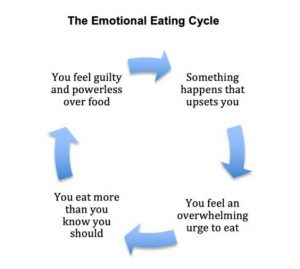By: Krista Hoose
It is probably safe to say that this year has made most people very much aware of their emotions–the good, the bad, and the indifferent. According to the American Psychological Association (2020), an emotion is “a complex reaction pattern … by which an individual attempts to deal with a personally significant matter or event.” The significance of the matter or event determines what emotion is felt. It is no secret that people express, and at times suppress, their emotions in different ways. Emotional eating is consuming food in response to negative emotions, such as fear, frustration, stress, anxiety, sadness, or anger. The act of eating is used to cope with the emotion that is felt, or it could also arise from confusing cues of hunger and fullness with changes in the body due to experiencing the emotion (Konttinen, 2020).
The purpose of this article is not to diagnose, treat, or provide any supplemental therapy of any kind. The goal is to bring awareness that emotional eating is not to be viewed as a weakness, and that experiencing and reacting to negative emotions is a normal part of life. Furthermore, rather than using mechanisms such as eating to ignore or distract from an emotion, there are resources to recognize stress and manage it in healthy ways. Stress management is an important topic to personal trainers because of the effect that increased stress can have on the body (e.g., poor quality of sleep, increased cortisol, lack of energy), which could impact the client’s overall well-being and response to training (Padgett, 2020).
Stress management strategies are individual, meaning that what works best for one person may not be someone else’s number one tool. The goal is to find a mechanism that you are comfortable doing, works for you, and you can develop into a habit. Stress management strategies generally fall under three areas–mindfulness exercises, therapy, and physical exercise. It is important to note that if the stressor is ongoing, severe, or due to trauma or grief, a therapist or other health professional is recommended. The following are some techniques that may be helpful in managing stress (Padgett, 2020):
- Meditation or deep breathing
- Journaling
- Grounding (i.e., sitting quietly and paying attention to the five senses)
- Body scanning (i.e., paying attention to each muscle from your toes to your head)
- Calling a friend
- Taking a walk
- Yoga or stretching
- Going outside for fresh air
- Listening to your favorite song or playlist
- Taking a nap
- Exercising
- Prioritizing sleep
- Planning balanced nutrition
- Relaxing activities, such as taking a bath or reading a book
- Prioritizing hobbies and friendships
- Engaging in art, such as coloring, drawing, or music

Mindfulness is the act of shifting one’s attention to the present. To apply this practice to mindful eating, one would slow down, pay attention to feelings of hunger and fullness, and eat until satisfied. Some strategies for mindful eating include: removing distractions such as phones, books, and televisions while eating; slowing down between bites by chewing more thoroughly, setting down the utensil, or taking sips of water between bites; scheduling meals and snacks throughout the day to avoid getting overly hungry; setting snack calendar reminders for those who get too busy to remember to eat; staying hydrated to avoid confusing cues of thirst and hunger; and utilizing a hunger scale before and after eating to help focus on cues from your body (Padgett, 2020).
A hunger scale is a numbered scale from 1 to 10 identifying the varying degrees of hunger and fullness cues within the body. Using a scale before and after eating can help differentiate true hunger versus an emotional response. The following 1-10 hunger scale is such an example (Padgett, 2020):
- Starving, feeling weak/dizzy
- Very hungry, irritable, low energy, stomach growling
- Pretty hungry; stomach beginning to growl
- Beginning to feel hungry
- Satisfied; neither hungry nor full
- Slightly full/pleasantly full
- Slightly uncomfortable
- Feeling stuffed
- Very uncomfortable; stomach aches
- So full you feel sick
A food journal can also be utilized along with a hunger scale to recognize patterns and behaviors to help reduce stress and to plan for potential stressful situations that might trigger an emotional response. Such a journal entry might list the date, time, hunger scale rating before and after eating, what was consumed and how much (approximately), and the emotion felt (Padgett, 2020). It can then be explored why an emotion is felt and if there are any patterns associated with a particular emotional trigger. One could then plan ahead by scheduling their favorite mindfulness strategy to help process the emotion.
One more consideration that may intensify emotional eating is strict dieting. By restricting food to such a degree as deeming it forbidden, may result in craving and emotional eating. Develop a plan to allow those favorite foods in moderation. This may be more effective than labeling a food as off limits and arousing negative feelings about such a restriction.
Your personal trainer and the team at UFit are here to help identify stressful triggers and to develop healthy response strategies to stress. Just like exercising and vacations, we can help plan ahead for known stressors, within our scope of practice, or help point you in the right direction within the health field. Behavior change and forming new habits is achievable one step at a time, whether it is exercise- or nutrition-related. Know that we support you in your goal and care about your overall well-being inside and outside of the gym!





